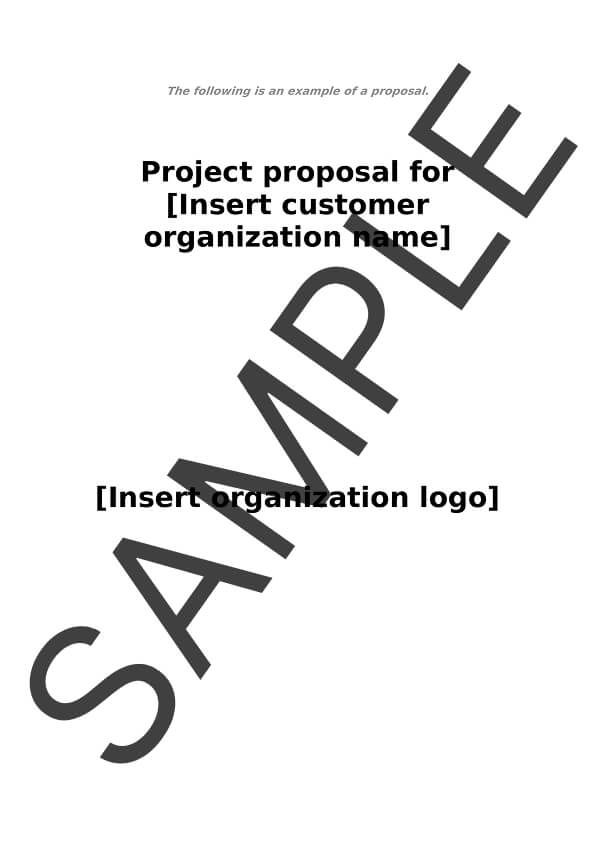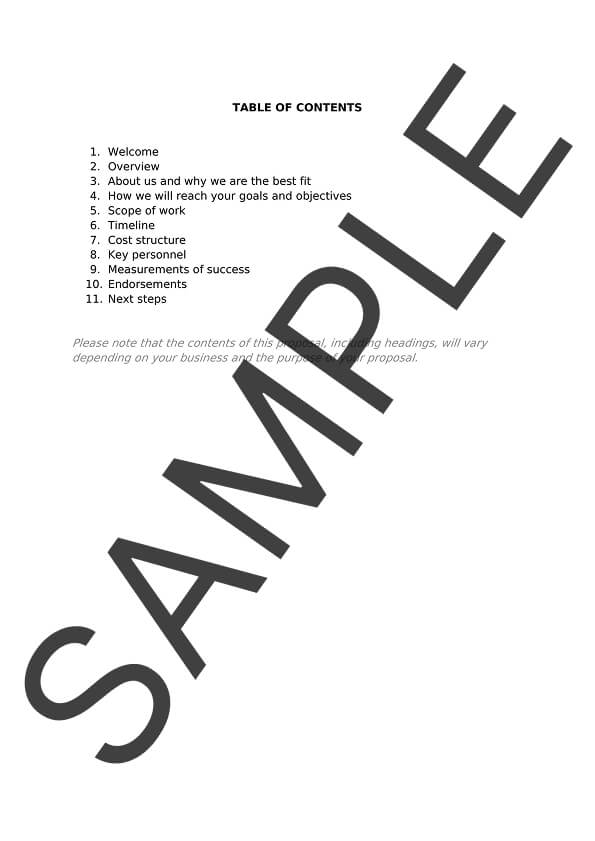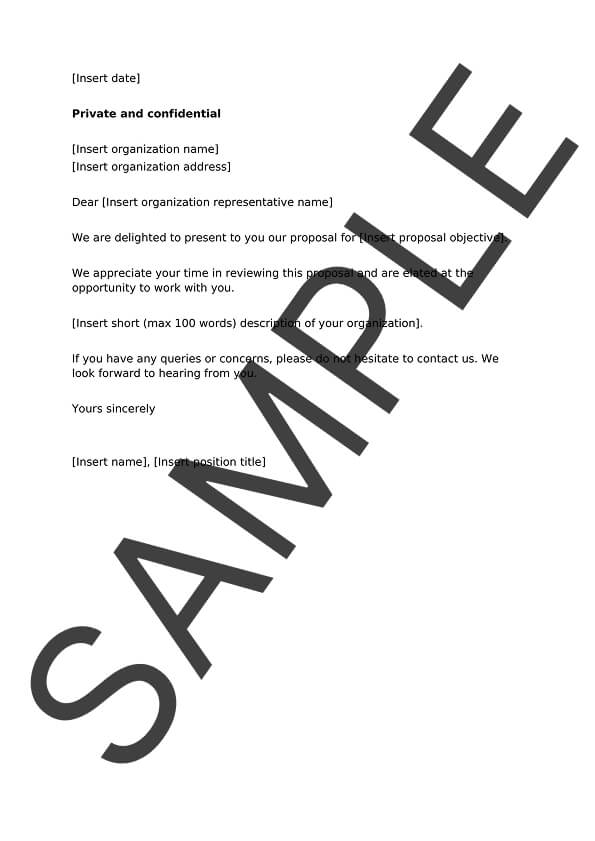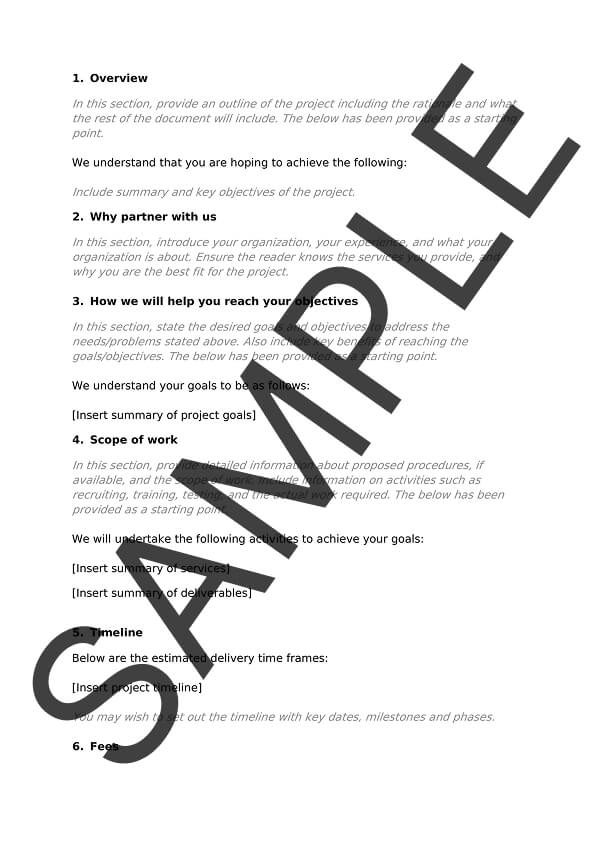Do you have a legal question and want to speak with our sister company Legal Kitz, book a free 30 minute consultation.
Polished layout that showcases your business credibility instantly.
Adapt every section to match your brand and specific client needs.
Pre-built framework eliminates starting from scratch every time.
Convert proposals to signed contracts with integrated e-signatures.




A proposal template is your blueprint for creating persuasive business documents that convert prospects into clients. Think of it as a professionally designed framework with all the essential sections, formatting, and structure you need, ready to customise with specific details. Rather than staring at a blank page wondering where to begin, you start with a proven format that guides you through creating a comprehensive, compelling proposal.
Using proposal templates through a comprehensive document management system transforms how you approach business development. You're not just saving time; you're ensuring consistency across all your proposals, maintaining professional standards, and focusing your energy on what matters most – crafting the perfect solution for your client's needs.
The beauty of modern proposal templates lies in their flexibility. Whether you pitch a million-dollar enterprise solution or a boutique consulting service, the right template adapts to your needs while maintaining the professional polish that wins business.
Every business opportunity is unique, so having access to different proposal templates matters. Let's explore the main types that drive business growth across industries.
Business proposal templates form the foundation of B2B communications. These versatile documents help you present partnership opportunities, outline service agreements, or pitch innovative solutions to potential clients. General business proposals typically include sections for company overview, proposed solution, implementation timeline, and investment details – all structured to build trust and demonstrate value.
Partnership proposals take this further by focusing on mutual benefits and shared goals. When proposing a strategic alliance or joint venture, your template needs sections highlighting synergies, defining roles and responsibilities, and outlining how both parties will benefit. Investment proposals, meanwhile, require additional elements like financial projections, market analysis, and return on investment calculations.
The key to practical business proposals? Starting with templates that already include these critical sections, then customising them to speak directly to your prospect's unique situation and goals.
Project proposals demand precision and clarity, especially when dealing with complex deliverables and timelines. IT project proposals balance customisable specifications with business benefits, while construction proposals require detailed scope definitions, material specifications, and safety considerations. Marketing campaign proposals blend creative vision with measurable objectives and budget allocations.
What makes project proposal templates invaluable is their ability to ensure nothing falls through the cracks. When juggling multiple stakeholders, deliverables, and deadlines, having a structured template keeps your proposal comprehensive. Their centre allows you to adapt templates for different projects, making project proposal templates invaluable for project types while maintaining consistency in presenting complex information.
Sales proposals are where preparation meets opportunity. Product sales proposals need to showcase features while emphasising benefits, include competitive comparisons, and present pricing in ways that demonstrate value rather than cost. Service proposals focus more on expertise, methodologies, and past successes, building momentum in your ability to deliver results.
For SaaS businesses, proposal templates need sections for implementation timelines, training requirements, and ongoing support structures. The subscription model requires pricing presentations different from one-time purchases, and your template should guide you through presenting these options. Innovative sales teams maintain libraries of proposal templates for various scenarios, ensuring they can respond without sacrificing quality.
Understanding what makes proposals successful starts with mastering their core components. Each section serves a specific purpose in moving your prospect toward a favourable decision.
Your executive summary is arguably the most critical component – it's often the only section every stakeholder reads. This one-page overview needs to capture attention immediately, clearly state the problem you're solving, present your solution at a high level, and highlight the key benefits of choosing your approach. Think of it as your elevator pitch in written form.
Effective executive summaries follow a simple formula: acknowledge the client's challenge, present your understanding of their goals, outline your proposed solution, and state the primary benefits they'll receive. Keep it concise – ideally under 300 words – while ensuring it stands alone as a compelling argument for your proposal.
After hooking readers with your executive summary, dive deeper into their challenges. Your problem statement demonstrates a deep understanding of their situation, showing you've done your homework and genuinely comprehend their pain points. Use their language, reference their industry challenges, and empathise with their position.
Your solution section then positions your offering as the natural answer to these challenges. Don't just list features – connect each element of your solution directly to the problems you've identified. Show how your approach addresses not just the immediate issue but positions them for future success. This is where your expertise shines through, demonstrating why you're the right choice beyond just price or your identified problem-solving abilities.
Clarity breeds confidence. The immediate issue and abstract promises are translated into concrete commitments. Break your project into clear phases with specific milestones, showing exactly what happens when. Include not just your deliverables but what you need from the client at each stage – successful projects require collaboration.
When outlining deliverables, be specific without overwhelming. Each deliverable should have a clear description, acceptance of your deliverables, and transparency, which helps prevent scope creep and ensures everyone shares the exact expectations from day one. Your legal documents can support this section with formal statements of work when needed.
Money talks, but it doesn't have to dominate the conversation. Present your pricing within the context of value delivered, using clear tables or visual elements to make costs transparent and easily understood. Consider offering multiple options when appropriate – good, better, best packages give clients control while often encouraging higher-value selections.
Your terms and conditions section protects both parties while building trust. Include payment schedules, revision policies, intellectual property considerations, and any assumptions underlying your proposal.
The difference between a template and a winning proposal lies in customisation. Here's how to make templates truly yours while maintaining their professional structure.
Start by thoroughly reviewing your chosen template, understanding why each section exists and how it contributes to the overall narrative. Then, begin personalising with your prospect's specific information – not just their name and company, but their industry terminology, particular challenges, and stated goals. Your document hub should become your customisation workshop, where templates transform into targeted business tools.
Brand consistency matters more than you might think. Beyond adding your logo, ensure your proposal reflects your brand voice, uses your colour scheme appropriately, and includes relevant case studies or testimonials. Every touchpoint reinforces your professionalism and attention to detail.
The most effective customisation happens at the strategy level. Adapt your value proposition to address their specific situation, adjust your timeline to match their urgency, and present pricing in ways that align with their budgeting process. Generic proposals feel generic – customised proposals feel like solutions designed specifically for them.
Success in proposal writing comes from following proven practices that separate average proposals from exceptional ones. Let's explore what makes proposals truly compelling.
Research forms the foundation of every excellent proposal. Before customising any template, invest time in understanding your prospect's business, industry challenges, competitive landscape, and specific goals. This research informs every customisation decision, from your language to the solutions you emphasise. The best proposals feel less like sales documents and more like strategic recommendations from a trusted advisor.
Focus relentlessly on benefits rather than features. While it's tempting to showcase everything you can do, winning proposals concentrate on what matters to the specific client. Translate every capability into a tangible benefit that addresses their goals or challenges. Remember: they're not buying your service, they're purchasing the results your service delivers.
Language matters more than most realise. Use clear, concise sentences that communicate complex ideas simply. Avoid jargon unless you're sure your audience uses those terms regularly. Write in active voice, use strong verbs, and eliminate unnecessary words. Every sentence should move your argument forward.
Social proof transforms proposals from promises to proven solutions. Include relevant case studies, testimonials from similar clients, or statistics demonstrating your success. When prospects see others like them achieving results, your proposal shifts from theoretical to achievable. Position these elements strategically throughout your proposal, not just in a dedicated section.
The business case for using professional proposal templates is compelling. Consider the typical proposal creation process: research, writing, formatting, review, and revision often consume 8-12 hours per proposal. With well-designed templates, that time drops to 2-4 hours while improving quality and consistency.
Cost savings extend beyond time. When you factor in the opportunity cost of senior staff crafting proposals from scratch, the financial impact becomes clear. Templates allow your best people to focus on strategy and customisation rather than formatting and structure. Plus, you accelerate the entire proposal-to-contract cycle. The financial impact becomes clear when features like document signing are integrated into your workflow. A significant benefit is improved win rates. Professionally designed proposals simply perform better. They look more polished, communicate more clearly, and demonstrate the organisational capabilities that give clients confidence. When every proposal maintains high standards, your brand reputation strengthens with each submission.
The compound effect is powerful: save time on each proposal, submit more proposals with the time saved, win a higher percentage of those proposals, and build a library of proven templates that get even better over time. It's a virtuous cycle that drives business growth.
Professional proposal templates aren't just documents – they're strategic business tools that drive growth, save time, and win more deals. When you combine proven structures with thoughtful customisation, every proposal becomes an opportunity to showcase your expertise and professionalism.
The path forward is clear: stop starting from scratch and begin leveraging templates that embody best practices while allowing for the customisation that makes each proposal unique. Your following winning proposal is just a template away.
Ready to revolutionise how you create proposals? Access our comprehensive library of free proposal templates and discover how Business Kitz makes creating professional, winning proposals easier than ever. With our integrated document management system, you'll have everything you need to impress clients and grow your business – all in one place.
IMPORTANT NOTICE: While you are purchasing a very comprehensive template, it is important to understand that the purchasing of this template is not considered legal advice. If you require legal advice and support utilising this template, you will need to consult a lawyer.
We've helped businesses save $55m with our all-in-one platform. Get instant access to this template and 115+ others, plus AI-powered document creation, starting completely free.
Copyright © 2025 Business Kitz 14312161